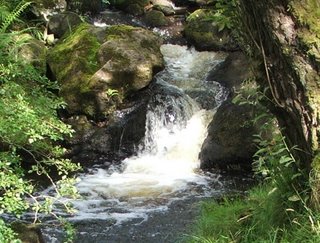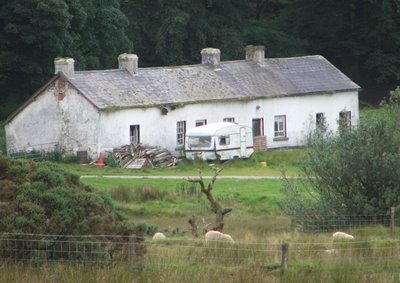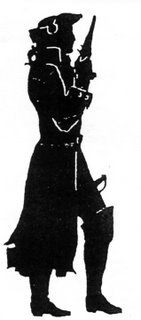My Writings (I hope!) reflect my Guiding Principles: -'Enjoy Life to the Utmost but not at other people's expense'-'Think Global, Act Local'-'Variety is the Spice of Life'-'Use Technology & Wisdom to Make the World A Better Place for All God's Creatures'-'Do Not Accept Injustice No Matter Where You Find It'-'Laughter is the Best Medicine'
'Nature without Borders'- North & South Ireland unite to Restore Native Ecosystems
Bloody Sunday massacre in January 1972 was part of a wider campaign of oppression against the nationalist community of Northern Ireland
Ballymurphy Massacre & the British State’s Dirty War in Northern Ireland.
Memories of the Lisdoonvarna Folk Festival
Ireland's first weekend youth musical festival took place during the summer of 1978 in what was then a backwater- Lisdoonvarna in County Clare. Thanks to the foresight of Jim Shannon and Paddy Doherty, it was the Electric Picnic of its time & an Irish equivalent of Woodstock.
The festival was billed as a Folk Festival. But though it started as an upbeat all-Irish Feilé, it expanded its repertoire over the years and hosted some of the finest musical acts on the planet including Jackson Browne, Van Morrison, Rory Gallagher, Emmylou Harris and Planxty.
 |
| Maria O'Malley from UCG & Mayo at Lisdoonvarna, 1978 |
Largely peaceful, the 1983 festival was marred by eight drowning fatalities at nearby Tra Leathan and by the violence that broke out when Hells Angels, inexplicably hired as festival security(!), started to beat up some of the festival goers. Thus ended a magical festival that corresponded too and reflected much of my fun student days and my political awakening.
For me, my happiest memory was in 1981 when Irish supergrpup Moving Hearts (Christy Moore, Davy Spillane, Declan Sinnott...) played highly politicized songs from their album of the same name. Songs such as 'No Time for Love', 'Hiroshima Nagasak'i and 'Before the Deluge' reflected the conflict in Northern Ireland, the H-Blocks, the early global environmental and the anti-war movements that were a largely youthful response to the real threat of mass annihilation that could have emanated from the 'Nuclear Arms Race' then taking place between the USSR and the USA.
Thatcher: A Destroyer of Communities
When she became Prime Minister in 1978, she used the words of St. Francis to define the tenets of her new government, “Where there is discord, may we bring harmony. Where there is error, may we bring truth. Where there is doubt, may we bring faith. And where there is despair, may we bring hope."
 |
| Thatcher with Pinochet |
US President Ronald Reagan and Thatcher were united in building a new expensive generation of nuclear missiles (Cruise & Pershings) that were to be placed on British and European soil. This decision spawned an international peace movement that included the huge female peace camp outside the RAF base at Greenham Common Berkshire where these weapons were to be sited.
Thatcher used all the forces of the state to destroy traditional mining communities in England.
The Poll Tax left to high levels of civil unrest.
She left Britain a deeply divided unequal society.
 |
| Thatcher with Rupert Murdoch |
Bloody Sunday: Truth & Justice at Last!

June 2010 was an historical month for Ireland & Britain. Truth and Justice finally won out over decades of state propaganda and blatant lies as a British government finally admitted that the 14 people killed in Derry by the British Army on Bloody Sunday 1972 were unarmed innocent civilians taking part in a Civil Rights march.
The Saville Report stated that the soldiers called before it had lied; that none of those killed were carrying weapons, that no warnings were given, that no soldiers were under threat at the time and that the soldiers were the first to open fire.
These findings totally contradict the statements of the British army and officialdom from the time of the killings onwards. Particularly scurrilous were the findings of the Widgery report published in April 1972 which was recognised at the time by independent minds as nothing more than a whitewash. For in spite of evidence to the contrary, Lord Widgery concluded that the soldiers were fired on first and blamed the marchers for participating in an illegal march (which was part of ongoing peaceful protests calling for an end to discrimination against Catholics in Unionist Protestant statelet of Northern Ireland).
Northern Ireland during the 'Troubles' (1969-1990s) was used by the British Army and the British secret services as a real laboratory for testing out methods, tactics and weapons that could be used someday to combat expected social unrest in Britain (and were to a degree used in mid-1980s in areas of British inner cities such as Brixton & Toxeth). Internment and non-jury courts were introduced. A series of miscarriages of justice took place where innocent Irish people were jailed for crimes that they did not commit. The most notable were the Guildford Ford and the Birmingham Six jailed in the 1970s and finally exonerated and released in 1991. (I played a humble and small part in this campaign, being chairperson in the laste 1980s of the West of Ireland 'Release the Birmingham 6 & Guildford 4' committee)
British forces, their agents and their loyalist allies also undertook a series of covert operations both in Northern Ireland and the Irish republic that included bank raids, shootings, secret assassinations, bombing, many of which were deliberately blamed on the IRA in an effort to discredit Irish civil rights activists and republicans. Some day the truth of the British establishment's secret and dirty war in Northern Ireland will be made known and published.
But in the meantime- Fair play to Prime Minister David Cameron for being the first British leader to apologise unequivocally over military crimes against civilians. Truly historical.
Northern Ireland’s Sperrin Mountains–a hidden Rural Gaelic heartland
I have just spent a few wonderful days living in the midst of the Sperrin Mountains, a region of untold natural beauty and a stronghold of vibrant Gaelic culture. I was pleasantly surprised to come across such a vast area of largely unspoilt natural beauty in development-driven Ireland. Unlike most of the rural regions of the Irish republic that are sadly being urbanised at an alarming rate, there are here stringent controls on building and road construction, on overgrazing as well as the ample provision of state funds to protect natural heritage.
I was pleasantly surprised to come across such a vast area of largely unspoilt natural beauty in development-driven Ireland. Unlike most of the rural regions of the Irish republic that are sadly being urbanised at an alarming rate, there are here stringent controls on building and road construction, on overgrazing as well as the ample provision of state funds to protect natural heritage.
Our northern brethren & the British government can teach us southerners a thing or two on environment protection and land management.
The Sperrin region consists of a landscape of gently rolling mountains, deep valleys (glens), small streams and boglands where ‘sheep’ is king.
 Here farming seems to be thriving: you can see young farmers driving tractors, sheep pens dotting the hillsides and busy market days in towns such as Draperstown.
Here farming seems to be thriving: you can see young farmers driving tractors, sheep pens dotting the hillsides and busy market days in towns such as Draperstown.  Sizeable government grants are provided to stop sheep grazing mountains at certain times of the year so flora can blossom and provide cover for nesting birds.
Sizeable government grants are provided to stop sheep grazing mountains at certain times of the year so flora can blossom and provide cover for nesting birds.
 This farm building is home to the 'sheep collector', a man whose job is collect stray sheep and return them to their owner. The animals are identified by the colour and shape of the dye on their wool.
This farm building is home to the 'sheep collector', a man whose job is collect stray sheep and return them to their owner. The animals are identified by the colour and shape of the dye on their wool. The Flaming Red of the Rowan Tree
The Flaming Red of the Rowan Tree
At this time of year in the Sperrins, one of the great Irish trees of Celtic mythology- the 'Mountain Ash'- gives a beautiful red colour to the autumn days. Also known as the 'Rowan', or 'Caorthann' in Irish, the red berry fruit of this tree only matures in the autumn thereby providing much needed food to wildlife. Its redness and bearer of autumn food made it associated in ancient Celtic times with life giving properties and with fire.
Amazingly for the 21st century, you come across more cyclists, walkers and farm vehicles than cars along the narrow roadways.
A large re-forestation programme is underway. Though primarily commercial and dominated by conifers, nevertheless it is helping to re-introduce the forests that once dominated the landscape. Interestingly, copses of trees woods sprinkle the hillsides planted by farmers to provide shelter for their sheep
The Sperrins are reminiscent of an Ireland that existed 150 years ago.
 Mountain Stream
Mountain Stream The intricate detail shown in the stone walls of this old farm building is testimony to the superb
The intricate detail shown in the stone walls of this old farm building is testimony to the superbcraftmanship of the buliders of a bygone era
The area is also steeped in pre-history: it is a treasure trove of stone circles and megalith tombs some dating back 5,000 years.
Catholic Highlands & Protestant Lowlands But it is its living folk traditions that helps bolster the unique identity that is the Sperrins. Traditional Gaelic music thrives in the pubs and schools; the names of most mountains, rivers, woods and towns are Gaelic in origins and labelled on all road signs. Monuments and posters to IRA volunteers and hunger strikers give visual expression to the strong republicanism that permeates many of the local population, the majority of whom are Catholic. Television news bulletins over the last few decades often spoke of finds of secret weaponry caches in the Sperrins. The inaccessible terrain with its dozens of abandoned farmsteads must have provided safe hide-outs for many an armed republican. Interestingly, locals also speak of other visitors staying incognito in these old buildings, namely British army undercover squads their presence often identified by the butts of their cigarettes left behind.
But it is its living folk traditions that helps bolster the unique identity that is the Sperrins. Traditional Gaelic music thrives in the pubs and schools; the names of most mountains, rivers, woods and towns are Gaelic in origins and labelled on all road signs. Monuments and posters to IRA volunteers and hunger strikers give visual expression to the strong republicanism that permeates many of the local population, the majority of whom are Catholic. Television news bulletins over the last few decades often spoke of finds of secret weaponry caches in the Sperrins. The inaccessible terrain with its dozens of abandoned farmsteads must have provided safe hide-outs for many an armed republican. Interestingly, locals also speak of other visitors staying incognito in these old buildings, namely British army undercover squads their presence often identified by the butts of their cigarettes left behind. A Roadside Poster Sign dedicated to the IRA prisoners who died on hunger strike in British jails in their efforts to have the British authorities accord them 'political' rather than 'criminal' status
A Roadside Poster Sign dedicated to the IRA prisoners who died on hunger strike in British jails in their efforts to have the British authorities accord them 'political' rather than 'criminal' status
 An old abandoned farm house. Notice its three-levelled structure which I believe was divided as follows: the larger section was for human habitation, the middle section for storage of grain and somtimes larger animals and the smallest section for poultry or pigs
An old abandoned farm house. Notice its three-levelled structure which I believe was divided as follows: the larger section was for human habitation, the middle section for storage of grain and somtimes larger animals and the smallest section for poultry or pigsIt was a lean and hungry life in the Sperrins; the dozens of ruined homesteads bear grim testimony to the harshness of their new existence which eventually forced many to emigrate.
‘Raparrees’: Ireland’s ‘Robin Hoods’ But the natives did not accept the loss of their lands lightly. From the forests of the Sperrins, armed raids were launched on the settlers in the lowlands during the seventeenth, eighteenth and early nineteenth centuries. Many of these rebels became famed in song and verse for taking on the British occupiers, robbing wealthy colonists and giving the money to starving and destitute people many of whom were now reduced to the status of tenants on their former lands. These armed horsemen were known as ‘Tories’ but more usually as 'Rapparees' and were looked as by the local populace as the Irish equivalent of the English ‘Robin Hoods’. The term ‘Rapparees’ probably derives from a mix of Irish (ri= king) and French (rapier=sword) words that translates as the ‘King’s Swordsmen,’. For many of these highwaymen were originally Gaelic Catholic gentry who had joined the army of the Catholic British King James 1 in the hope of reclaiming their lost lands.
But the natives did not accept the loss of their lands lightly. From the forests of the Sperrins, armed raids were launched on the settlers in the lowlands during the seventeenth, eighteenth and early nineteenth centuries. Many of these rebels became famed in song and verse for taking on the British occupiers, robbing wealthy colonists and giving the money to starving and destitute people many of whom were now reduced to the status of tenants on their former lands. These armed horsemen were known as ‘Tories’ but more usually as 'Rapparees' and were looked as by the local populace as the Irish equivalent of the English ‘Robin Hoods’. The term ‘Rapparees’ probably derives from a mix of Irish (ri= king) and French (rapier=sword) words that translates as the ‘King’s Swordsmen,’. For many of these highwaymen were originally Gaelic Catholic gentry who had joined the army of the Catholic British King James 1 in the hope of reclaiming their lost lands.
Probably the most famous Sperrin outlaw was Shane Crossagh who operated in the late 17th and early 18th centuries. According to Jim McCallen in his book ‘Stand & Deliver’, Shane’s real surname was “McMullan’; Crossagh meaning ‘pock-marked’ was a nickname. He took to the hills after he narrowly evaded capture during a secret visit to his family’s former home from whence they had been evicted. There are many tales of his gang’s daring exploits. One relates to a British General Napier who was overheard by Shane boasting in an inn one night that he would have the rebel’s head on a pike within the week. Next morning the general and his cavalry unit were ambushed by Shane’s men at a bridge near the village of Feeny. After the soldiers were forced to surrender, they were stripped, tied up in pairs and marched off led by General Napier dressed up as a women!
Brave Death of a Raparree
But Shane was eventually caught and sentenced to be hanged along with his two sons. However, he was surprisingly offered pardon by an influential planter Henry Carey, whose life he had once saved. But when he was told that his sons were not to be spared, he declined the offer of a pardon. According to a witness- John Low the Presbyterian minister of Banagher- he died with a son either side of him, holding each by the hand after making a speech to an sympathetic crowd thanking them for their support over his years as an outlaw.
 The place of Presbyterian worship in the centre of Draperstown. Not as ornate as a Catholic or Anglican church, nevertheless it possesses an innate beauty of its own.
The place of Presbyterian worship in the centre of Draperstown. Not as ornate as a Catholic or Anglican church, nevertheless it possesses an innate beauty of its own.









